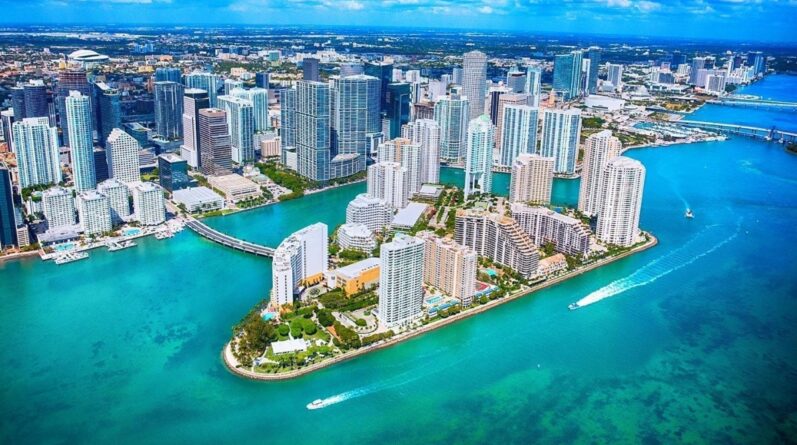
Florida has become a wildly popular relocation destination over the past decade, as has Texas. About a thousand people a day relocate here, at least that's what the media writes in the headlines for the last 3-4 years. Read today in USA.ONE Magazine:
Why Miami is so livable
From climate, politics and taxes to prices and entertainment.
Climate
«Sunshine state» — so nicknamed Florida because of the 300 sunny days a year. You can swim in the ocean and surf all year round, and in general the Atlantic Ocean is noticeably warmer than the Pacific. In Miami, you do not need warm clothes, even at night in winter it is very warm. In summer, it is very hot, even stuffy: an average of +27 degrees, and because of the tropics it can be too humid.

Miami is located in the south of Florida, in the tropical climate zone. The climate is characterized by high temperatures, high humidity and occasional rains. Summer in Miami starts in June and lasts until the end of September. At this time, the average air temperature is about 30 degrees Celsius, and humidity reaches 70-90%. Daytime temperatures can reach 35 degrees, and at night it does not drop below 25 degrees.
Autumn in Miami is quite warm and humid, the average air temperature in October and November is about 25-28 degrees. Winter in Miami is relatively warm and dry. The average air temperature in January and February is about 20-23 degrees, and at night it can drop to 15 degrees. A small amount of rain falls during this period of the year.
Spring in Miami is also warm and humid, with the average air temperature in March and April being around 25-28 degrees. There may be some rain during this time of the year, but it is usually short-lived. In general, Miami has a warm and humid tropical climate, which makes this city attractive for beach holidays all year round. However, high humidity and occasional rain must be taken into account.
Economy, politics and taxes
Florida attracts large American companies to do business because of low taxes. This is a huge merit of the Republican governor of the state — Ron DeSantis. Due to the budget surplus, he even decided to return some of their money to the taxpayers. He is the most popular governor in the States and could be the next president.
Miami is one of the largest economic centers in the United States. The economy here is diverse and based on many industries such as tourism, international trade, finance, healthcare and real estate.
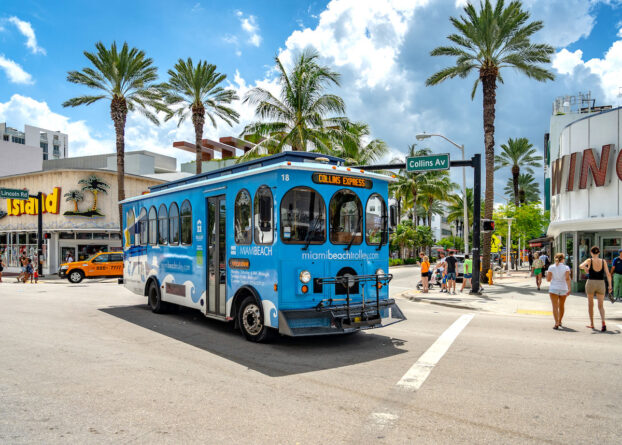
Tourism is one of the most significant sectors of Miami's economy. The city annually receives millions of tourists from all over the world thanks to its beautiful beaches, hotels, restaurants, shops and other entertainment.
Miami is also a major international trade center that links Latin America and North America. The city has many ports, airports and warehouses that serve the logistics and transportation of goods to various regions.
The financial sector also plays an important role in Miami's economy. The city is home to many major banks, investment companies and funds that finance local and international projects. Healthcare is another important industry in Miami's economy. The city is home to many hospitals, clinics and medical centers that cater to locals and tourists.
Real estate also plays an important role in Miami's economy. The city is constantly building new residential and commercial buildings, and real estate prices in Miami are among the highest in the United States. Overall, Miami's economy is vibrant and diverse, heavily dependent on tourism, international trade, and financial services.
Miami is part of the state of Florida, and as such, state tax laws and local political structures apply. Taxes in Miami include state and municipal taxes. Florida does not have a personal income tax, which makes it attractive to many people and businesses.
However, there is a Sales Tax, which is 6% of the cost of goods and services. In some municipalities, such as Miami Beach, this tax can be increased to 7-8%. There is also a property tax, which is about 1-2% of the assessed value of the property.
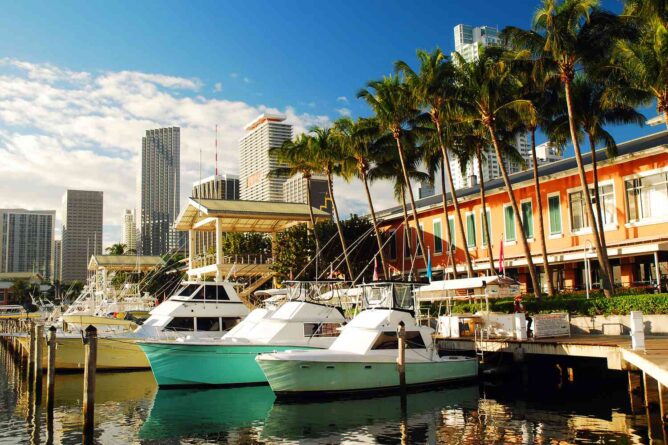
Miami's political structure includes a mayor and a city council that governs the city. The city also has a strong lobbying community and many civic organizations that influence political decisions.
Miami is a politically diverse city with a predominantly democratic political outlook. However, the city also has a significant number of conservative residents and businesses.
Overall, Miami's tax system is relatively attractive to businesses and residents due to the lack of personal income tax. Miami's political structure is dynamic and diverse, which is reflected in a wide range of political views and community organizations.
People
The city is colorful with its diversity of foreigners. First of all, we are talking about immigrants from Latin America, specifically in Miami — from Cuba. About 80% of the city's residents know Spanish, and many simply ignore English. The Little Havana area is insanely atmospheric, as if not in America. But don't forget about the Sunny Isles, where you can hear the Russian language and a lot of shops with Russian food.
Miami is a city with a diverse and diverse national culture, in which people of different ethnic and social groups live. Some of the largest communities in Miami:
- Hispanics: Miami is home to many Hispanic immigrants, mainly from Cuba, Venezuela, Colombia, Argentina, Mexico, and other Latin American countries. Spanish is widely used in Miami and can be heard everywhere from streets and shops to offices and schools.
- African Americans: The city has a large African American community that is concentrated in Liberty City, Overtown and other areas. African Americans have played an important role in Miami's history, including civil rights and the music industry.
- Europeans: Miami also has a significant number of European immigrants, including Spaniards, Italians, French, Germans, and others. Many Europeans are drawn to Miami's culture and lifestyle, as well as business and tourism opportunities.
- Asians: Miami has a small but rapidly growing Asian community, primarily Chinese, Japanese, Koreans and Indians. They form numerous communities that are attracted to Miami for work, education and business.
- Others: Miami also has a significant number of residents who represent other ethnic groups, including Russians, Arabs, Iranians, and others.
Overall, Miami is a culturally diverse city with a wide range of nationalities and social groups that create a unique atmosphere and lifestyle of the city.
Megacity 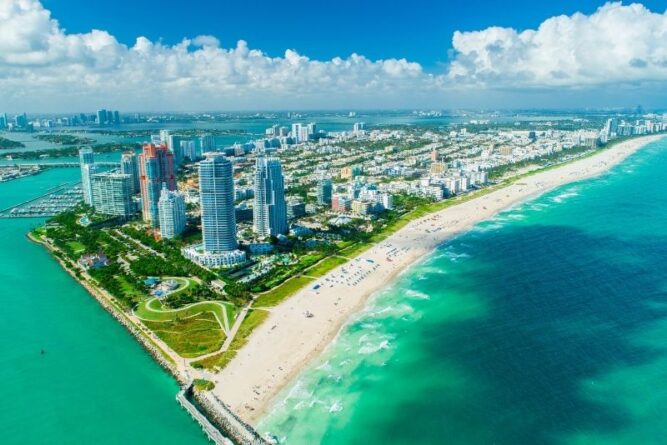
Miami is the largest metropolitan area in the southeastern United States. The population is about 6 million people, which makes it the fourth largest city (after NY, LA and Chicago). It is one of the most important financial centers in the USA. Miami is recognized as the 20th city in terms of GDP.
Miami is not only an economic center, but also a cultural and entertainment center. The city is full of museums, theatres, galleries and concert halls, as well as famous festivals and events such as Art Basel, Miami Music Week and Ultra Music Festival.
One of the most famous symbols of Miami is its beaches, which attract many tourists and locals. Miami has several major beaches, including South Beach, Miami Beach, and Key Biscayne.
Like any major metropolitan area, Miami has its own problems, such as traffic congestion, crime, and housing inaccessibility for the lower and middle classes of the population . However, the city is actively working to solve these problems, and over the years has made significant investments in the development of infrastructure, social programs and housing.
Overall, Miami is a major metropolitan area that has many advantages and disadvantages, but has a unique culture, atmosphere, and lifestyle that attracts many people and makes it one of the most attractive cities in the United States.
Miami Beach 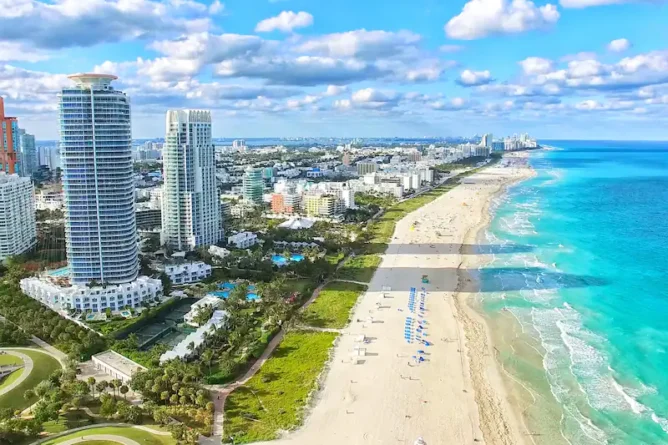
One of the most party places in the USA, only Vegas is cooler. Miami Beach is always noisy, pathetic and alcoholic. Celebrities live and vacation there, and 30 million tourists from all over the world come to feel like characters in a Hollywood movie.
Miami Beach is a popular resort town on the southeast coast of Florida, located on islands of the Barrier Reef between Biscayne Bay and the Atlantic Ocean. The city borders Miami to the north and south, and Mid Beach to the north and south.
Miami Beach is famous for its beautiful sandy beaches that attract many tourists and locals. South Beach is the most famous beach in Miami Beach, it is located in the heart of the city and attracts many people due to its beauty, many restaurants, shops and nightlife.
Miami Beach is also a popular shopping destination, especially on Lincoln Road — a pedestrian street where shops, cafes, restaurants and art galleries are located. The city is also known for its art deco architectural landmarks, such as the Delano and The Raleigh hotels, which were built in the 1930s.
What's the price?
The average salary in Miami can vary depending on the industry a person works in and their professional skills and work experience. On average, according to the Bureau of Labor Statistics, the median annual salary in Miami is around $55,000.
Some of the highest paying jobs in Miami include financiers, lawyers, doctors, engineers, managers, and information technology professionals. In these industries, wages can reach significant sums.
However, it should be noted that Miami also has low wages in some industries such as service and trade. Average wages in these industries can be significantly lower than in other industries.
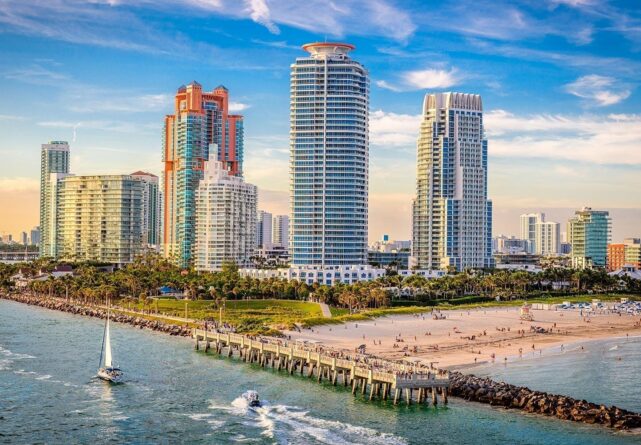
In addition, it is worth considering that prices for real estate, transportation, food and entertainment in Miami can be higher than in other cities in the United States, which can affect the standard of living and purchasing power of people. Monthly spending per person without rent is about $1200.
Due to the influx of people, housing in Miami is no longer as cheap as it was a couple of years ago. You can rent a room from $750 per month, and two-room apartments — from $1500. Much depends on the area and your personal needs. You can find both cheaper and more expensive, use the sites Zillow.com and Apartments.com. Below are approximate prices for renting housing in Miami in 2023:
- Studio: $1,000 to $2,000 per month
- 1-room apartment: $1,500 to $3,000 per month
- 2-room apartment: $2,000 to $5,000 per month
- 3-room apartment: $3,500 to $7,000 per month
- House: $2,500 to $10,000 per month.
However, it should be noted that rental prices in Miami can be taller in popular areas like South Beach, Brickell, and Downtown Miami. It's also worth considering that most rental contracts in Miami are for a year or more, and additional costs may include utilities, home insurance, and other fees.
In general, rental prices in Miami can be higher than in other cities in the United States, but this depends on many factors such as location, size and condition of housing. Here everything is built, developed, expanded, lives and does not stand still.
Did you like the article? Share it with your friends on social networks and don't miss even more content on our website!